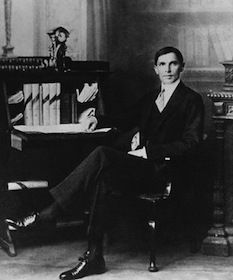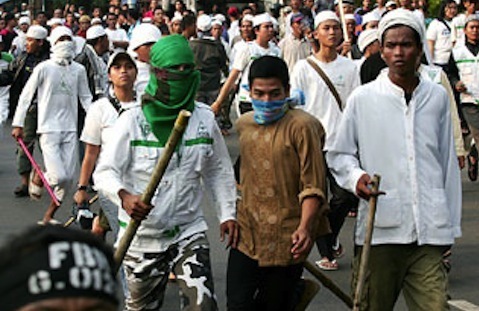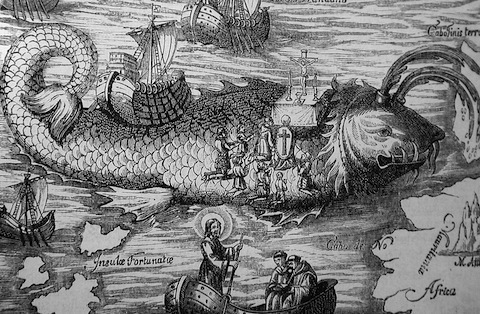Brendan I. Koerner's Blog, page 58
October 19, 2010
The Turnaround
Doing a quick trip down to Florida for some reporting, so either working or traveling for a short bit. Will try and use some downtime to read this 1831 tract, which bears one of the most irresistible titles in all of literature: A narrative of the wreck of the Minerva: whaler of Port Jackson, New South Wales, on Nicholson's shoal, 24° S. 179° W..
October 18, 2010
The Kevin Durant of Bus Driving
 Thanks for Microkhan Jr.'s increasing obsession with all things mechanical, I recently found myself trolling through the hundreds of transit-related videos on this YouTube channel. It is quite an amazing collection, the handiwork of a New York City metrophile who apparently spends the bulk of his leisure time filming buses and subways. And among his many clips is this gem from a 2008 Metropolitan Transit Authority "roadeo," a contest in which bus drivers show off the skills they've developed while navigating Gotham's perilous streets.
Thanks for Microkhan Jr.'s increasing obsession with all things mechanical, I recently found myself trolling through the hundreds of transit-related videos on this YouTube channel. It is quite an amazing collection, the handiwork of a New York City metrophile who apparently spends the bulk of his leisure time filming buses and subways. And among his many clips is this gem from a 2008 Metropolitan Transit Authority "roadeo," a contest in which bus drivers show off the skills they've developed while navigating Gotham's perilous streets.
The clip piqued my interest in the culture of roadeos, which are far more competitive than you might imagine. The sport, in fact, has its own Hall of Fame, honoring such landmark figures as Robert "The Big Z" Zuzworsky and Brentt Mackie. Who is likely to someday join this legendary drivers in the roadeo pantheon ? My money is on Rex Schrock, an up-and-coming Teamster from Nevada, who has won his regional roadeo for four years straight. (Photographs from his latest triumph here.) Though he has yet to triumph at the national championship, it should only be a matter of time. I recommend that you get on the bandwagon now.
Yet there is one thing that bugs me about America roadeos, and that's the fact that the customer-service aspect is not compulsory. Such is not the case in New Zealand, where roadeo champs must prove that they can be calm in the face of adversity:
Nimon & Son driver Barrie Gledhill travels to Dunedin today to represent Hawke's Bay for the third time in the annual Tranzqual Bus Roadeo.
Nimon operations manager Ian Hughes is confident Mr Gledhill will do well for the Havelock North company. "Barrie was the winner of the Commercial Road Skills Award for Excellence in Customer Service," he said.
Mr Gledhill is looking forward to defending his customer-service title. "Last year we role-played different situations," he said. "There was a man who had lost his wallet, a dazed and confused passenger and a lady who was late and screaming at me."
There is something rather Buddhist about this challenge, for the only way to shrug off such provocations is to free one's self of ego. And that must surely be difficult for roadeo champs accustomed to widespread adulation.
October 15, 2010
The Failed Heartthrob
There's a great scene in Robert Altman's The Player in which Tim Robbins' slithery movie producer stops a writer who's in the middle of pitching a script idea. The poor scribe, it seems, made the mistake of implying that his proposed film would feature a TV star in the main role. This notion makes Robbins scrunch his brow in puzzlement, thereby forcing the writer to backtrack and explain that the producer must have misheard him—his project would not cast a TV star, but rather have a movie star playing a TV star. This clarification greatly pleases Robbins.
That exchange elucidates the scant regard that Hollywood gives to stars of the small screen. Yet every once in a while, the industry tries to take a hot TV commodity and turn him or her into a bona fide cinematic artist. More often than not, the results are disastrous—a sad fact made abundantly clear in this week's Bad Movie Friday entrant, the atrocious 1987 vehicle My Demon Lover.
For those too young to remember the Reagan Years, Valentine was a late addition to the cast of Family Ties, playing Justine Bateman's roughneck-cum-bohemian boyfriend. NBC tried to spin off his character, Nick, in a sitcom of its own, but that idea never got past the pilot stage. Still, Hollywood thought that Valentine's Stallone-like good looks made him worth a gamble, and thus cast him in My Demon Lover as "a homeless street musician becomes a demon when sexually aroused." Nothing good came of this decision, as explained here:
The best that can be said for "My Demon Lover" is that the film makers have worked overtime shuffling characters, locations and wrinkled latex masks with horns. Mr. Valentine, who appears in the masks, plays a supposedly charming vagrant who has been mysteriously cursed and appears to borrow almost all of his screechy, importunate mannerisms from the comedian Bobcat Goldthwait, who handles them a lot better. At other times Mr. Valentine merely widens his eyes and pretends, none too convincingly, to be adorable.
[No one] pays heed to the larger implications of [Valentine]'s condition or worries unduly when he turns into a large, motherly woman whose head is full of yellow goo. The settings range from Greenwich Village, where the spunky Denny has her cluttered career-girl apartment, to Central Park, where the action moves to a huge, ominous hilltop castle. By the time the castle appears, it seems no less irritating or misplaced than anything else.
Valentine's career took a nosedive from there, especially after the cancellation of Family Ties. Still, I'm sure he's earned an extremely comfortable living in years hence, playing supporting roles in such C-grade fare as Black Scorpion. Unlike Microkhan, then, Valentine probably doesn't stand around the supermarket wondering whether he should splurge on the can of beans that costs 30 cents more. So I guess he wins.
The Proverbial Thousand Words
 The current issue of Granta contains an enlightening Jane Perlez piece about Muhammad Ali Jinnah (right), Pakistan's founding father. In making the argument that Jinnah's vision for the nation has been grossly misinterpreted, Perlez notes that it's easy enough to determine where a Pakistani official resides on the political spectrum. All you have to do is take a look at the portrait of Jinnah that hangs above his desk, as she did when visiting a friend at his Peshawar office:
The current issue of Granta contains an enlightening Jane Perlez piece about Muhammad Ali Jinnah (right), Pakistan's founding father. In making the argument that Jinnah's vision for the nation has been grossly misinterpreted, Perlez notes that it's easy enough to determine where a Pakistani official resides on the political spectrum. All you have to do is take a look at the portrait of Jinnah that hangs above his desk, as she did when visiting a friend at his Peshawar office:
Government offices are important symbols in Pakistan—size, furniture, scope of retinue. This one was handsome, a large room set off a broad veranda in the ersatz Moghul-era quadrangle of pink stucco. A white mantelpiece signaled the dignity of the office holder. Above it hung a portrait, more a sketch in dingy brown, of Pakistan's founding father, Muhammad Ali Jinnah. The face was gaunt and elderly—an aquiline nose, sunken cheeks, unforgiving mouth. A peaked cap high off his forehead and a plain coat buttoned to the neck gave the aura of a religious man…
A few months later I returned to see my friend. Same signing of documents, same clerk, different portrait above the mantel. The new visage showed a serious young man with a full head of dark hair, an Edwardian white shirt, black jacket and tie, alert dark eyes. What happened? I asked.
"I would like to see Jinnah brimming with life," my friend said. He did not want to be reminded of the clerical image that is now considered politically correct in many places throughout Pakistan.
This passage got me thinking about the ways in which visual representations of major political figures shape our perception of their intentions—often incorrectly, and by design of those in power. So much of a nation's identity is bound up in how we understand its mission statement, as crafted by the people who brought the enterprise together in the first place. But those founders were inevitably human, and their motives and ideals were often murkier than we'd care to admit. As Perlez points out in her piece, Jinnah never quite hashed out how the Islamists would be incorporated into Pakistan; he used their lingo to gain support for the nation's creation, but he didn't give enough thought to how they would mesh with his vision for a tolerant society. And he was far too quick to bargain away vast swaths of territory, without giving much thought to how those missing chunks would poison Pakistani politics down the road.
But we do not want our national heroes to be flawed figures. And so we depict them as full of confidence and valor—and, most important, as embodiments of the values that we've come to embrace in the decades or centuries since their passing. This may seem harmless enough, but the sad case of Pakistan must give us pause. Artists have warped Jinnah's visage to present us with a figure who bears little resemblance to the brilliant idealist who hoped that Pakistan might follow Turkey's lead in blending modern and traditional values. Or as Perlez puts it:
The Jihadistan that looms on the horizon as a the future of Pakistan, a likely compromise between extremist groups and the army, would not have a place for Jinnah today.
Can anyone think of other major political figures whose artistic representations now give us a skewed sense of their beliefs?
October 14, 2010
Bobbing Along
Just one of those dour days here in Atlah, with the brain creaking along so slowly that the firing of each synapse sounds like the bursting of a soap bubble. Classic ZZ Top will have to see you through for the moment. And if you have a few spare moments over lunch, it's worth checking out this primer on what to expect from Burma's upcoming elections. One major fly in the junta's repressive ointment? The long-running ethnic insurgencies that run shadow governments along Burma's borders:
The major setback for the military regime in this process has been its inability to disarm the ethnic groups, transform them into border guards and make them contest as political parties. Despite repeatedly postponing the deadlines for this process, the regime has neither disbanded them legally nor resorted to military confrontation with these groups. It is widely believed that China had a role to play in mediating between the regime and the ethnic groups especially in the borders with China. The regime has put this issue in the cold storage with a view to revive it after the dust settles down after the elections. However the military regime has withheld the election in some townships of these troubled areas in the states of Kachin, Kayah, Kayin, Mon and Shan (including four townships in the Wa self administered division) for the reason that "the election will not be held in several constituencies where free and fair elections could not be held".
More soon.
October 13, 2010
Beautiful Minds at the Fronton
My heart goes out to contemporary jai-alai players who must constantly answer a rather irritating question from casual observers: "Isn't your sport fixed?" The stars of the circuit have gone to great lengths to assure the public of jai-alai's credibility, but it's still tough to overcome some of the extreme shadiness that dogged the sport in the '70s and '80s.
Yet although many players have been nabbed for throwing games at the behest of organized crime, the greatest scandal ever to rock the world of jai-alai had little to do with the athletes themselves. Rather, it was all about a group of mathematical geniuses recognizing that the sport's entire betting system was poorly constructed. In 1979, Sports Illustrated broke down exactly how an organization known as the Miami Syndicate used its considerable brainpower to outsmart the house:
In doubles (the same rules apply to singles, but doubles account for nine or 10 of the 12 games on an evening's program), pair No. 1 plays pair No. 2 to begin each game. The winners of the opening point then play pair No. 3 and so on down the line to the No. 8 pair. In most games, after each of the eight pairs has had a turn on the court, a second round begins in which the winners get two points, instead of one, for each win. The first team to get seven points wins the game.
Analyses of trifecta combinations show certain numbers rarely win. For example, an $18 box bet on 678—which covers every possible combination of 6, 7 and 8—is a sucker bet; 678, 768 and 876 almost never come in, because those teams enter the game so late. The Miami Syndicate left sucker numbers out of its basic betting system in favor of combinations that mostly involved players on teams numbered 1 through 5.
The Courant's Driscoll has calculated that the Syndicate won about $1.12 for every $1 bet, a 12% profit. By comparison, an average bettor gets a return of only 82¢ for every $1 wagered', an 18% loss…
Systems betting isn't illegal, nor, incredibly enough, were the extraordinary privileges granted members of the Miami Syndicate by the Hartford fronton. They were given their own ticket puncher, their own cashier and access to computer printouts of the betting every 90 seconds while wagering was under way. Such printouts are not usually available to the public. Mark Wiesenfeld, the assistant mutuels manager, provided the printouts because, as he later testified, he thought they were "public documents." When Hartford Jai Alai stopped Wiesenfeld from doing this, John DeWees, a ticket puncher, began providing the information.
Having the betting printouts gave the Miami Syndicate a huge advantage. With access to them, the Miami Syndicate immediately knew what other bettors were doing. The printouts, which showed how many bets had been placed on each of the 336 trifecta combinations, allowed Syndicate members to stay away from the heavily played numbers and to bet on those that were less popular. Moreover, as it turned out, the printouts permitted the Miami Syndicate to spot other systems bettors and drive them out of the game by wagering so heavily on their numbers that the payoff on them was minimal. The Miami Syndicate had such total control and such an acute sense of how to "tune" the odds that members were even able to bet just enough on a trifecta so that a win would pay less than 300 to 1. By keeping the payoff to less than 300 to 1, Syndicate members could pocket all their winnings, instead of having the IRS withhold 20%, as it automatically does on all winning tickets on payoffs of 300 to 1 or more.
The top members of the Syndicate earned roughly $7 million a year, which is nothing to sneeze at. But they're probably kicking themselves now for not applying their math skills to even more lucrative endeavors that reward the ability to play the angles.
Of course, the defenders of jai-alai's credibility are not without their own math nerds.
October 12, 2010
Gangs of Jakarta

The Indonesian capital is still reeling in the wake of a deadly gang brawl outside a city courthouse. As in most cases of Jakartan gang violence, the young men involved belonged to rival ethnic groups, each with close ties to local politicians who rely on thuggery to manage their constituencies. In fact, it appears that these politicians may have instructed police to take no action when the gangs started amassing for the fight; as one Indonesian criminologist noted, the gangsters "would not dare appear in front of hundreds of police officers, flaunting sharp weapons and firearms, unless they are confident that nobody can touch them."
The means by which these gangs control vast swaths of Jakarta with their patrons' blessing is detailed in this essential 2007 paper, a close study of the deceptively named Batawi Brotherhood Forum (FBR):
The organizational backbone of the FBR is its gardu structure of small security posts, usually situated near intersections, markets or bus terminals. Currently the FBR has approximately 185 gardu spread throughout the greater Jakarta region, with the highest concentration being in Cakung. Emulating the territorial command structure of the Indonesian military as well as the pos siskamling neighborhood surveillance system setup by the New Order in the 1990's, individual gardu are coordinated by a district commander who in turn reports directly to FBR's central board. Gardu are led by a coordinator and an advisory council, who are given a mandate by the central leadership to seek funds and take action against drug traffickers, alcohol vendors and entertainment venues considered immoral.
One of the main roles of the FBR therefore, has been to establish itself as a quasi-state in the traditional Betawi homeland areas of East and Central Jakarta. "We work with the police, army and government as long as it doesn't conflict with Sharia…We are ready to join together with the police and the army to eliminate preman". This involves not just the policing of the area, but also the employment of state paraphernalia and symbolism- uniforms, sirens, motorcycle escorts.
The FBR is also notable for the rather polite extortion letters it sends to local businesses:
With this letter we request the assistance of your business in providing a routine monthly donation to help cover FBR's operational costs. If you choose to disregard this request then we will assume that you do not care
about the aspirations or welfare of the Betawi people as the indigenous population of Jakarta. This being the case, we, the Betawi Brotherhood Forum will do something to your business that is not in accord with your
aspirations.
This is obviously yet another case of the state ceding governance to a militia, simply because this is easier than actually centralizing control. (Related on Microkhan: Jamaica.) The theory is that the armed groups will always recognize that they must remain subordinate to their political patrons, in exchange for free rein on the streets. But that unspoken contract tends to get broken as the militia leaders' power swells. The streets and the statehouse and inextricably linked—a truly prosperous society cannot pretend otherwise.
October 11, 2010
Here There Be Monsters

Columbus Day brings to mind all the various explorers who are more deserving of modern recognition than the dour Genoan you either love or loathe. One such admirable icon is our namesake, St. Brendan, who allegedly sailed across the Atlantic Ocean in the sixth century A.D. True, there is zero physical evidence to prove that this voyage actually occurred, though it does seem feasible based on the maritime technology of the day. But even if it's all a lie, you have to love the strange adventures that St. Brendan's chroniclers cooked up—I am fairly certain that Christopher Columbus never mistakenly alighted upon a giant fish:
At last they went upon an island weening to them that they had been safe, and made thereon a fire for to dress their dinner, but S. Brandon abode still in the ship, and when the fire was right hot and the meat nigh sodden, then this island began to move, whereof the monks were afeard, and fled anon to ship and left the fire and meat behind them, and marvelled sore of the moving. And S. Brandon comforted them and said it was a great fish named Jasconius, which laboreth night and day to put his tail in his mouth, but for greatness he may not.
There are obviously elements here of Jonah and the whale, as well as the Ouroboros. I'd also like to think that the good folks behind The Empire Strikes Back had this anecdote in mind when they cooked up that setpiece about the Exogorth.
October 8, 2010
"We Got Robots, We Got Cavemen, We Got Kung Fu…"
In order to round out a gestating Wired essay, I spent a good chunk of this past week drumming up examples of celluloid robots. One invaluable resource that I relied upon was this excellent Wikipedia entry, which mentions a number of B-movie 'bots that vanished from my memory banks. Perhaps the most laughably cheesy of those humanoid machines is Mandroid, the star of this week's Bad Movie Friday honoree: 1986′s Eliminators.
The trailer above really speaks for itself, and comes highly recommended. (Also worth two minutes of your time: this motorcycle battle scene, which culminates with a clever manipulation of laser physics, followed by a fat dude's promise of revenge.) But if you're in an office where video is verboten, just check out this fine review. My favorite snippet:
Somehow, with an entire globe to search, Mandroid finds Col. Hunter, only to discover that it is . Hunter is a robotics whiz, and recognizes most of Mandroid's outfitting as derived from her work. She has also created an odious little sub-Black Hole droid that bleeps like R2-D2, flies around, and can turn into a cartoon that zips about at a Speedy Gonzales clip. Hunter patches up the Mandroid, and they set out for Mexico.
Once there, they must find a guide, as the Mandroid's memory chips were shot up. Hunter does this by striding into a bar and saying, "I want the toughest guide in the place," which sets off a monumental bar fight. The actual winner of the fight is a diesel dyke named Bayou Betty, but she is coldcocked (so to speak) by wily lovable rogue Harry Fontana (Andrew Prine, in a role which cries out for ). In the trip down the river, they must not only deal with the vengeful Bayou Betty, but the Overweight Head Thug and his Raul Julia Clone.
Additional Eliminators fun fact: the Mandroid was played by tobacco heir Patrick Reynolds, who has since turned against the sot-weed in dramatic fashion.
October 7, 2010
Promises, Promises

The federal government is becoming increasingly zealous about deporting convicted criminals who've completed their sentences. That official enthusiasm has led to some interesting legal conundrums, such as this case of an oil worker down in Texas:
A descendant of the Lipan Apache tribe who was convicted this summer of re-entering the United States after being deported was sentenced Wednesday to 14 months in federal prison.
Erick Ricardo Bonilla, 32, an oilfield worker who had lived in Odessa for six years before his arrest, will likely be deported after he is released, defense attorney Justin E. Weatherly said.
Bonilla's mother had a green card, but Bonilla was born in Juárez, Mexico, "by accident," Weatherly said. At trial, Weatherly argued that even though the federal government does not recognize the Lipan Apache, Bonilla should be allowed to live in the United States under the promise of "perpetual friendship" outlined in an arcane treaty between the Lipan people and the Republic of Texas.
The treaty in question, signed in January 1838, can be read here. The defense attorney's argument is obviously novel, and one must have some sympathy for Bonilla give the federal government's extremely poor track record of fulfilling its treaty obligations with Indian tribes. However, the real legal question is whether the federal government was bound to honor treaties made by the Republic of Texas after the unusual Ordinance of Annexation in 1845. I'm guessing that annexation voided all of the defunct Republic's diplomatic efforts, which means that Bonilla's lawyer can only get an A for effort.
But would the case be different if the Lipan Apache were federally recognized? The tribe has been vying for such recognition for an awful long time, but it's a tough row to hoe:
Historically, tribes have been granted recognition through treaties, by the Congress, or through administrative decisions within the executive branch. In 1978, the Bureau of Indian Affairs established a regulatory process for recognizing tribes. The current process for federal recognition, found in 25 C.F.R. 83, is a rigorous process requiring the petitioning tribe to satisfy seven mandatory criteria, including historical and continuous American Indian identity in a distinct community. Each of the criteria demands exceptional anthropological, historical, and genealogical research and presentation of evidence. The vast majority of petitioners do not meet these strict standards, and far more petitions have been denied than accepted. In fact, only about 8 percent of the total number of recognized tribes have been individually recognized since 1960.
One potential stumbling block for the Lipan Apache: Due to warfare with the U.S. Army, the ranks of the Lipan Apache were reduced to less than 20 members by 1885, and they were all prisoners of war. Proving lineage from such a small ancestral group will be tough.




